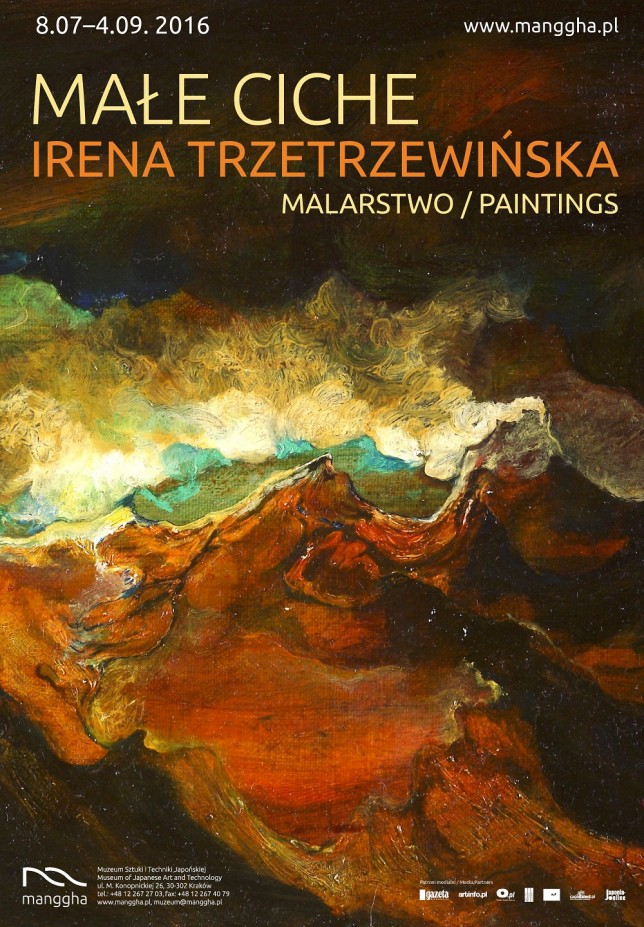Exhibition: "małe ciche" | Poland
 In the context of a new project which focuses on the representation of nature in Japanese and Western art, the Manggha Museum of Japanese Art and Technology, in Krakow, Poland, an ASEMUS member, has recently inaugurated an exhibition entitled "Małe ciche. Irena Trzetrzewińska. Paintings", which will remain open until 4 September.
Irena (Rena) Trzetrzewińska was born in 1934 in Zapusta-Czyżów near Sandomierz, into a wealthy family. Her grandfather Józef Targowski had travelled to the Far East in 1919, as a Minister Plenipotentiary and High Commissioner of the Republic of Poland, becoming the reborn state’s first representative in Japan and China. The manor at Czyżów was visited by Wyczółkowski, Skoczylas, Gombrowicz, poets, authors, musicians and theatre makers. In a career spanning several decades, she has taken part in over ninety group exhibitions at home and abroad and received a large number of prizes and commendations, e.g. in the Salon of the Young (1965), the exhibition ‘A Tribute to Wyspiański’ (1979), and the Salon of Painting and Sculpture (1997). Her works are included in the collections of the Archdiocesan Museum in Warsaw, the National Museum in Krakow, the District Museum in Radom, as well as a number of other collections at home and abroad.
In her work, she paints small compositions in oils and pastels, inspired by nature, its combined phenomena of decomposition and resilience. They are still lifes featuring fruit in various stages of decay, and also landscapes – primarily in the Tatra Mountains.
While Tatra motifs were something obvious and indisputable in the art of the two decades between the wars, after 1945 things were slightly different as the young artists’ interests, and the changes in art per se, tended to eliminate those themes. That process was, however, never completed, owing to the graduates of Krakow’s Academy of Fine Art. A particularly intense power of expression can be found in the Tatra works of three of them: Andrzej Wróblewski (1927–1957), Irena Trzetrzewińska (b. 1934), and Władysław Klamerus (1956–1992). What emanates from their paintings is a suggestive, dark mood, full of tension, close to the Romantics’ vision
These compositions attack our senses: we can feel, sometimes even hear, the wind in the mountains and find ourselves in a fearful awe of them. Those artists knew the topography of the mountains very well. One can’t help assuming that their works included depictions of the alpine peaks and valleys that they actually traversed. Nothing could be further from the truth. What these, otherwise very different artists, have in common is a vision or impression of the Tatras created by sheer experience of, or contact with, the mountains. They also share an extraordinary ability to translate into a visual language experiences and sensations that seem untranslatable. Jacek Buszyński aptly noted that Rena Trzetrzewińska ‘has taken up the grand and inexhaustible subject of the mountains. Painting the Tatras for the past few years, she has been reminding us that every affection can and should be expressed in art in spite of the currently prevailing prejudices and common opinions. Even more so when you consider that it is not easy to rediscover the mountains using the painterly means, i.e. to reveal one’s own vision of them on canvas. The artist behind these small pictures in oils has confidence in her own impressions and in the painterly matter. Applied lightly, the translucent areas of colour, their outlines and mutually permeating layers, are suggestive of homogenous alpine space: a hugeness of the massive rocks, a vastness of the sky and the clouds, a sheen of light forming a theatre of nature that is homogenous while filled with dramatic contrasts. We are not going to see a static panorama of the mountains or souvenir de paysage here. We rediscover, in an intimate setting, the motif of perennial mythologies and the aura of great Romantic exaltation – the pathos of the alpine landscape.’
Indeed, these small, seemingly intimate paintings emanate some primordial horror and fear of the unknown. ‘In Trzetrzewińska’s work, mountain tops emerge from a thoroughly thought-out play with painterly matter in dense pictures glowing with a kind of phosphorescent sheen,’ Jacek Woźniakowski, a unique connoisseur of Tatra landscapes, wrote in 1995. The impression is further intensified by the poetic titles – wordplays: Krzesany, Smutna, Gorzelisko, Błękitny. Each of them sounds like a name of a peak, a ridge, or a glade. It would, however, be a vain effort to look for them in Tatra guidebooks. Their nature is rather that of fantasy and legend; they introduce us to an unknown and unknowable world. The artist looks around in the Tatras much like Alice in Wonderland and paints what she has seen ‘through the looking glass’. The mountains remain unknown, and the still lifes small and quiet (‘małe ciche’).
[Extracts above taken from the text by curator Anna Król]
For additional information about the exhibition "Małe ciche. Irena Trzetrzewińska. Paintings", please visit http://manggha.pl/en/exhibition/76
In the context of a new project which focuses on the representation of nature in Japanese and Western art, the Manggha Museum of Japanese Art and Technology, in Krakow, Poland, an ASEMUS member, has recently inaugurated an exhibition entitled "Małe ciche. Irena Trzetrzewińska. Paintings", which will remain open until 4 September.
Irena (Rena) Trzetrzewińska was born in 1934 in Zapusta-Czyżów near Sandomierz, into a wealthy family. Her grandfather Józef Targowski had travelled to the Far East in 1919, as a Minister Plenipotentiary and High Commissioner of the Republic of Poland, becoming the reborn state’s first representative in Japan and China. The manor at Czyżów was visited by Wyczółkowski, Skoczylas, Gombrowicz, poets, authors, musicians and theatre makers. In a career spanning several decades, she has taken part in over ninety group exhibitions at home and abroad and received a large number of prizes and commendations, e.g. in the Salon of the Young (1965), the exhibition ‘A Tribute to Wyspiański’ (1979), and the Salon of Painting and Sculpture (1997). Her works are included in the collections of the Archdiocesan Museum in Warsaw, the National Museum in Krakow, the District Museum in Radom, as well as a number of other collections at home and abroad.
In her work, she paints small compositions in oils and pastels, inspired by nature, its combined phenomena of decomposition and resilience. They are still lifes featuring fruit in various stages of decay, and also landscapes – primarily in the Tatra Mountains.
While Tatra motifs were something obvious and indisputable in the art of the two decades between the wars, after 1945 things were slightly different as the young artists’ interests, and the changes in art per se, tended to eliminate those themes. That process was, however, never completed, owing to the graduates of Krakow’s Academy of Fine Art. A particularly intense power of expression can be found in the Tatra works of three of them: Andrzej Wróblewski (1927–1957), Irena Trzetrzewińska (b. 1934), and Władysław Klamerus (1956–1992). What emanates from their paintings is a suggestive, dark mood, full of tension, close to the Romantics’ vision
These compositions attack our senses: we can feel, sometimes even hear, the wind in the mountains and find ourselves in a fearful awe of them. Those artists knew the topography of the mountains very well. One can’t help assuming that their works included depictions of the alpine peaks and valleys that they actually traversed. Nothing could be further from the truth. What these, otherwise very different artists, have in common is a vision or impression of the Tatras created by sheer experience of, or contact with, the mountains. They also share an extraordinary ability to translate into a visual language experiences and sensations that seem untranslatable. Jacek Buszyński aptly noted that Rena Trzetrzewińska ‘has taken up the grand and inexhaustible subject of the mountains. Painting the Tatras for the past few years, she has been reminding us that every affection can and should be expressed in art in spite of the currently prevailing prejudices and common opinions. Even more so when you consider that it is not easy to rediscover the mountains using the painterly means, i.e. to reveal one’s own vision of them on canvas. The artist behind these small pictures in oils has confidence in her own impressions and in the painterly matter. Applied lightly, the translucent areas of colour, their outlines and mutually permeating layers, are suggestive of homogenous alpine space: a hugeness of the massive rocks, a vastness of the sky and the clouds, a sheen of light forming a theatre of nature that is homogenous while filled with dramatic contrasts. We are not going to see a static panorama of the mountains or souvenir de paysage here. We rediscover, in an intimate setting, the motif of perennial mythologies and the aura of great Romantic exaltation – the pathos of the alpine landscape.’
Indeed, these small, seemingly intimate paintings emanate some primordial horror and fear of the unknown. ‘In Trzetrzewińska’s work, mountain tops emerge from a thoroughly thought-out play with painterly matter in dense pictures glowing with a kind of phosphorescent sheen,’ Jacek Woźniakowski, a unique connoisseur of Tatra landscapes, wrote in 1995. The impression is further intensified by the poetic titles – wordplays: Krzesany, Smutna, Gorzelisko, Błękitny. Each of them sounds like a name of a peak, a ridge, or a glade. It would, however, be a vain effort to look for them in Tatra guidebooks. Their nature is rather that of fantasy and legend; they introduce us to an unknown and unknowable world. The artist looks around in the Tatras much like Alice in Wonderland and paints what she has seen ‘through the looking glass’. The mountains remain unknown, and the still lifes small and quiet (‘małe ciche’).
[Extracts above taken from the text by curator Anna Król]
For additional information about the exhibition "Małe ciche. Irena Trzetrzewińska. Paintings", please visit http://manggha.pl/en/exhibition/76Similar content
21 Oct 2016 - 29 Jan 2017
from - to
31 Aug 2013 - 23 Mar 2014
09 Feb 2016 - 20 Mar 2016
posted on
07 Jan 2016
29 Jul 2014 - 28 Sep 2014


